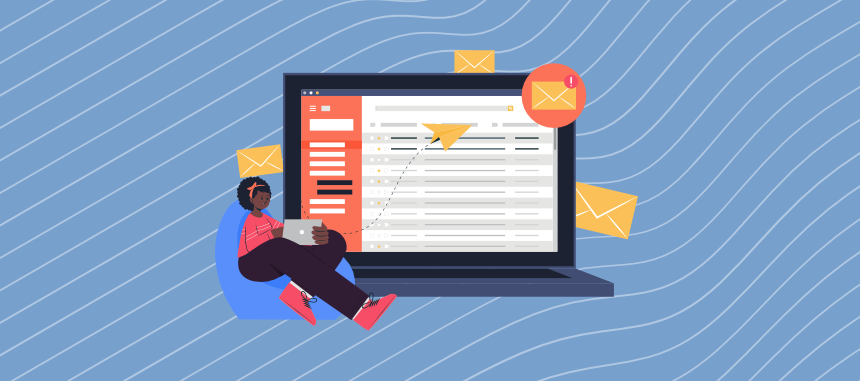Emails have always been an effective channel of communication for brands to connect with their customers.
The objective of an email campaign may vary from promoting new products or services to sharing important business news or valuable content.
Also, email marketing is a great choice for marketers and business owners who want to gather feedback from their customers.
Email surveys can be a game-changer for your marketing efforts, allowing you to target broader audiences and collect critical insights to optimize different parts of your marketing strategy. Let’s discover how!
What are email surveys and why should you use them?
Email surveys are questionnaires businesses incorporate into their emails to collect valuable feedback from their subscribers.
They could serve different purposes, such as collecting product feedback, tracking your customer team’s performance, and measuring user experience.
You can even use them to learn about why visitors abandon their carts or why recipients choose to unsubscribe from your email list.
No matter the specific objective, it’s a bulletproof method to improve your strategy and enhance customer satisfaction.
But it’s time to get more specific about the advantages of incorporating surveys in your emails:
- Quick data collection. Email surveys offer brands quick access to a diverse range of customer data. The responses come in almost immediately, enabling you to dive into timely analysis and data-driven decisions.
- Convenient to use. Creating email surveys and dispatching them to your recipients is only a matter of a few clicks. It’s also a simple and straightforward process for your subscribers to fill in at their convenience, thus making it a win-win situation.
- Reduced cost. A great advantage of email surveys is that they involve a very small cost. You can find a variety of free and low cost survey solutions in the market to create a dedicated survey based on your unique needs.
- Personalization options. Email surveys come with many personalization options to target recipients with tailored content. From adding their name to leveraging their purchase history, you can craft customized surveys that bring back an increased response rate.
7 Tactics to get the most out of email surveys
We’ve gone through why you should use email surveys in your email marketing. But how will you ensure that every email survey you send counts?
To help you out, we gathered the best tactics to urge subscribers to open your survey emails and participate.
1. Write engaging and clear email subject lines
As all email marketers will tell you, everything starts with your email subject line. If you want high email survey response rates, you have to increase your email open rates. And what is the number one prerequisite for people opening your emails?
You guessed that right, your email subject line. Well-written subject lines create great first impressions and entice readers to open the email and take the survey.
You may wonder how you will know that your email subject lines are the best you can come with. First of all, robust newsletter apps give you all the necessary tools to A/B test your subject lines by sending two email versions to different segments of your audience and check which performed better.
Moreover, some email marketing solutions, like Moosend, even come with an AI-powered email subject line tester. Such a tool facilitates creating strong subject lines by gathering data from a variety of sources and thousands of email campaigns.
But let’s go through some other tried and tested tactics to create effective subject lines:
- Make it clear. Your subject line should convey the purpose of your survey email in just a few words. It always works to include the actual words, such as survey or feedback, for readers to know exactly what the required action is.
- Include an incentive. If your survey email comes with an incentive (more on that later), your subject line should highlight it. Knowing there’s something in for them will give them motivation enough to take action.
- Use the first question. Consider adding the first question of your email survey to your subject line. This is a great way to warm your recipients up and directly engage them in a conversation, resulting in increased completion rates.
- Get creative. As with every email, adding some creativity in your subject lines is key for subscribers to open them. Include relevant and fun emojis, throw in some humor when appropriate, or bring out your audience’s pain points.
2. Show each subscriber that you value their feedback
You may send your email surveys to a large percentage of your email list – perhaps even all of them. However, each subscriber should feel that they were specifically selected to conduct the survey and that their individual opinion makes a difference to you.
How can you achieve that? Personalization is the secret sauce to create a sense of importance and convince your audience to participate.
Segment your recipients into different groups and dispatch relevant surveys according to the segmentation criteria you’ve set. From customizing your email content to adding personalized elements like images or videos, personalizing your survey emails increases recipient engagement.
Also, it’s imperative that your email survey questions are adjusted to each recipient’s behavior, actions, and level of awareness with your brand. For instance, applying the skip logic makes survey completion feel more relevant to each reader. Some survey tools allow you to show specific questions to respondents based on their previous answers.
For instance, if you reach out to collect feedback on a negative experience on your website, including customized content indicates that you value their opinion and care to do better. Especially when addressing concerns, approaching the issue on a one-to-one basis is essential.
In addition to that, make sure readers understand that you read their feedback and will take the necessary steps to improve. Don’t neglect to send a follow-up email to share the survey results and what your next actions will be based on the insights gained.
3. Keep your surveys short, concise, and well-structured
We can take one thing for granted: recipients have a short attention span and a plethora of marketing emails to read. As you can tell, making them fill out long surveys might result in abandoning the process.
So, your email surveys should be brief, concise, and centered around specific questions. EmployIng relevant questions aligned with your survey objectives goes a long way in getting high response rates and helpful feedback.
Don’t go overboard with multiple questions or asking insignificant questions. Making it as easy and quick as possible for subscribers to complete your survey is key to boosting your completion rate.
But if you absolutely need to add multiple questions, turn them into multiple-choice questions or use drop-down menus to facilitate the process. Also, your questions should be concise and easy to understand. Therefore, invest in clear and impactful wording instead of technical jargon that will tire users out.
Last but not least, it’s important to create email surveys that are easy to skim and visually appealing.
Choose clear and consistent formatting, offer participants straightforward instructions on how to complete the survey, and consider adding compelling visuals to create an even more engaging survey experience.
4. Optimize your sending time and frequency
Sending your emails at the right time is among the best-performing email practices, no matter the email purpose.
So, taking all the above into account will take you nowhere if you send your email survey at the wrong time. The right sending time ensures that your recipients will take the time to complete it.
Best email survey sending times may vary depending on your industry, survey type, or specific objective. Let’s say that you want to use your email survey to get feedback on a new product or service.
It makes sense to send your email survey soon enough for your customers to remember their experience, but not too soon because they probably won’t have spent enough time using it and will end up ignoring your email.
But the best way to nail your sending time is to test sending your email surveys at different times. This will help you discover the best-performing ones according to your audience’s habits and preferences and trace patterns that work. Also, don’t forget to test the frequency of your email surveys.
Overdoing it with this type of email campaign could lead to respondent fatigue and decreased completion rates.
As a general rule, it’s better to trigger surveys after specific user actions, like someone purchasing a product or watching a webinar. Or, if you need regular and comprehensive feedback, consider leveraging annually or quarterly email surveys.
5. Optimize for mobile
Even if you’re an entry-level marketer, you must know that the vast majority of your audience opens their emails on mobile devices.
Therefore, it’s imperative that you provide an optimized mobile experience for all users to view every element of your emails. Poor mobile experience is among the first reasons behind users with smaller screens abandoning emails.
• 85% of users use smartphones to access email. (Adobe)
• Mobile accounted for 42% of all email opens in 2019. (Litmus)
• The ratio between received and sent emails is 3:1. (Radicati)
• 47% of consumers use a mobile application for checking their email. (Campaign Monitor)
Source: 99Firms
Using mobile-friendly survey designs is essential to improve your response rate. Even better, invest in a survey tool that comes with responsive survey templates that allow you to create and share mobile-optimized surveys.
This way, your email surveys will render well on every device, ensuring that all users share an equal experience when offering their feedback.
6. Offer incentives to your respondents
More often than not, consumers wonder what’s in it for them when coming across a request to provide feedback. After all, they give your business part of their time, so it’s only natural that they ask for something in return.
When you create a survey email, make sure to highlight what they will gain if they participate in your survey. There’s no better way to do so than adding the incentive to your subject line for readers to have enough motivation to open your email.
Many business owners fear that offering incentives translates into spending a fortune but that’s not the case. It might be something as simple as exclusive content, free online courses, product samples, or free shipping coupons.
Such incentives are usually all it takes to grab recipients’ attention and enable higher completion rates. In case your survey requires more time than usual, consider offering a more valuable incentive such as a generous discount for their next purchase, a gift card, or access to premium trials.
7. Test and optimize your email surveys
Regardless of how well you know your audience, you can never be sure what resonates with them every time.
To take the guesswork out of your email surveys, it’s important to dispatch them to a small group of your subscribers first to detect and fix potential issues.
Also, running A/B tests will help you determine which components bring the best results and incorporate them in your strategy. You can try out variations and experiment with different incentives, number of fields, or question types.
After measuring the results, you can tell what works and where there’s room for improvement. This process, along with customer feedback, will give you all the insights required to optimize your email surveys over time.
Final words
Creating and sending email surveys to your target audience should be an integral part of your overall marketing strategy.
Asking for your recipients’ feedback helps you connect with your customers and get a deeper understanding of their needs and preferences.
By following these guidelines, you will get the most out of your email surveys, using them to inform your business decisions and provide your customers with memorable experiences.
About the author
Maria Fintanidou works as a copywriter for email marketing automation software Moosend, having created the Help Articles (FAQs) and overseen the platform’s translations in Greek and Spanish. She loves exploring new cultures and ways of thinking through traveling, reading, and language learning.




